Telomere-to-telomere DNA replication timing profiling using single-molecule sequencing with Nanotiming
- PMID: 39747057
- PMCID: PMC11696806
- DOI: 10.1038/s41467-024-55520-3
Telomere-to-telomere DNA replication timing profiling using single-molecule sequencing with Nanotiming
Abstract
Current temporal studies of DNA replication are either low-resolution or require complex cell synchronisation and/or sorting procedures. Here we introduce Nanotiming, a single-molecule, nanopore sequencing-based method producing high-resolution, telomere-to-telomere replication timing (RT) profiles of eukaryotic genomes by interrogating changes in intracellular dTTP concentration during S phase through competition with its analogue bromodeoxyuridine triphosphate (BrdUTP) for incorporation into replicating DNA. This solely demands the labelling of asynchronously growing cells with an innocuous dose of BrdU during one doubling time followed by BrdU quantification along nanopore reads. We demonstrate in S. cerevisiae model eukaryote that Nanotiming reproduces RT profiles generated by reference methods both in wild-type and mutant cells inactivated for known RT determinants. Nanotiming is simple, accurate, inexpensive, amenable to large-scale analyses, and has the unique ability to access RT of individual telomeres, revealing that Rif1 iconic telomere regulator selectively delays replication of telomeres associated with specific subtelomeric elements.
© 2024. The Author(s).
Conflict of interest statement
Competing interests: The authors declare no competing interests.
Figures




References
Publication types
MeSH terms
Substances
Associated data
- Actions
- Actions
- Actions
Grants and funding
- Allocation doctorale/Ministère de l'Education Nationale, de l'Enseignement Supérieur et de la Recherche (MENESR)
- Allocation doctorale/Ministère de l'Education Nationale, de l'Enseignement Supérieur et de la Recherche (MENESR)
- FRM FDT202106013030/Fondation pour la Recherche Médicale (Foundation for Medical Research in France)
- FRM EQU202203014910/Fondation pour la Recherche Médicale (Foundation for Medical Research in France)
- NanoPoRep ANR-18-CE45-0002/Agence Nationale de la Recherche (French National Research Agency)
LinkOut - more resources
Full Text Sources
Miscellaneous

